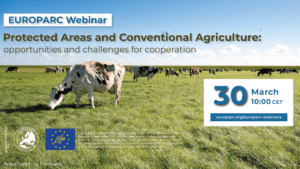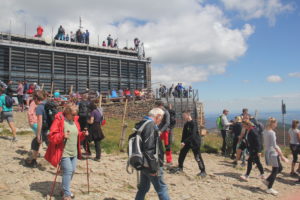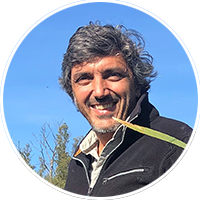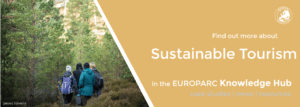Recommendations for a green and fair CAP reform
On Friday the 26th of March, the so-called “super trilogue” will take place to seek a breakthrough in the Common Agricultural Policy (CAP) talks. EUROPARC, together with 41 other NGO’s and civil society organizations have send a joint letter to the negotiators to urge them to bring the CAP in line with the EU Green Deal.
What is happening?
The CAP negotiations are complex and have been going on for multiple months now. To achieve a breakthrough in the CAP talks, the Portuguese Presidency of the Council of the European Union recently called a joint negotiation meeting – dubbed a super trilogue. Many nature-orientated NGO’s, as well as farmers, have been critical of the current state of the CAP and EUROPARC too believes that it is crucial that there is a better coherence between the CAP and the EU Green Deal.
This is why EUROPARC decided to sign a letter calling for an ambitious, green and fair reform of the Common Agricultural Policy (CAP). The letter was send out to the negotiators today.
What is needed?
The CAP file is divided into three pieces of legislation, dealing specifically with strategic plans, horizontal governance and common market organisation (CMO) of the EU’s agricultural policy. The European Parliament (EP) is represented by one negotiator for each dossier conducting separate negotiations. The Portuguese presidency aims for a comprehensive and systematic assessment of three regulations that make up the CAP reform.
In the letter, we urge the lead negotiators to implement the following five overarching priorities into the three CAP regulations:
1. Incorporate the principles, objectives and targets of the Green Deal into the CAP to give national Strategic Plans a clear direction from their design all the way to their approval and performance reviews;
2. Fully implement the ‘do no harm’ principle into the CAP through strong environmental and social conditionality and safeguards;
3. Empower farmers and rural actors to adopt climate-, nature-, people-, and animal-friendly farming practices and models through fair and effective CAP support;
4. Adopt adequate instruments to manage and regulate agricultural markets to limit overproduction, which causes waste, price crashes for farmers, and contributes to unsustainable trade, and to increase the fairness and transparency of supply chains;
5. Ensure good governance in the new CAP through strong rules on transparency, accountability of Member States for EU budget spending.
EUROPARC urges that the CAP is in line with the EU Green Deal and Farm to Fork strategy, to ensure good outcomes for nature, and for people.
Protected Areas and Agriculture
Agriculture and nature protection do not need to be at opposite sites of the spectrum. Many Protected Areas within Europe already work closely together with farmers on sustainable agricultural practices. On the 30th of March EUROPARC will take a closer look at the relationship between the agroindustry and Protected Areas in the webinar “Protected Areas and Conventional Agriculture: opportunities and challenges for cooperation”. Join us! You can register for free here.

COVID-19 takes a heavy toll on Protected Areas and nature conservation
Protected Area rangers play an essential role in nature conservation and environmental education. Photo: Kullaberg Nature Reserve
Consequences of the pandemic pose severe threats to Protected Areas and nature conservation efforts around the world. This gloomy conclusion results from a series of new research papers and articles published last week by IUCN.
The COVID-19 pandemic and its economic consequences have caused job losses among Protected Areas rangers, cuts in environmental protection funding and collapse in ecotourism around the globe. Needless to say, these setbacks could undermine global efforts to halt biodiversity loss and climate change.
Dr Bruno Oberle, IUCN Director General commented:
While the global health crisis remains priority, this new research reveals just how severe a toll the COVID-19 pandemic has taken on conservation efforts and on communities dedicated to protecting nature.
Published in a special issue of PARKS – the journal of the IUCN World Commission on Protected Areas, a collection of new studies and articles analysed the impacts of the pandemic on Protected Area operations. The publication also examined implications for recently adopted environmental policies, and how they are reflected in economic recovery packages and other governmental policies.
Budget cuts and collapse in tourism revenue
According to the IUCN synthesis, conservation efforts were most severely hit in Africa and Asia. More than half of Protected Areas in Africa, and about a quarter in Asia, reported that they had to halt or reduce field patrols and anti-poaching operations, as well as environmental education activities.
The pandemic was also a hard blow for the livelihoods of rangers and their communities. A survey of rangers in more than 60 countries found that more than one in four rangers had seen their salary reduced or delayed, while 20% said that they had lost their jobs due to the pandemic-related budget cuts.
What is the situation in Europe?
Despite closures and losses of tourism revenue, most Protected Areas in Europe maintained their core conservation operations. The surveys also show that European rangers weren’t affected as strongly as their peers from Central America and the Caribbean, South America, Africa and Asia.

Overcrowding of Europe’s Protected Areas posed serious issues during the first COVID wave. Photo: Jakub Kaspar
However, European Protected Areas have also met significant challenges arising from the COVID-19 pandemic. A study by FIDELIO research project found that impacts of COVID-19 and their policy implications put unexpected pressure on the parks and their staff, which naturally generated pleas for more support. These new challenges were mainly connected to overcrowding, new profile of visitors, their problematic behavior and conflicts between different groups.
COVID-19 and environmental policy
To also shed light on the impacts of the pandemic on environmental policy, the report analysed economic recovery packages and other government policies that were implemented or advanced in 2020. The experts identified some positive examples explicitly benefitting Protected Areas or scaling up environmental protection. For example, eight EU countries have set aside funding to expand or better manage Protected Areas, natural capital and the circular economy.
While 17 countries have maintained or increased their support for Protected Areas, 22 countries have on the contrary rolled back their environmental protection. In some cases, governments have even considered proposals to allow mining and fossil fuel extraction in Protected Areas. Mentioned in the report are for example proposals by the Brazilian government to allow mining and fossil fuel extraction in indigenous reserves, new permits in Russia to allow deforestation for transport and infrastructure in natural areas, and plans to explore and drill for oil and gas in the US Arctic.
Knowing the importance of healthy and protected nature, EUROPARC stands by all the affected Protected Areas and their rangers around the world. As expressed by Carlos Manuel Rodríguez, head of the Global Environment Facility:
We cannot say we are building back better unless we do so whilst also protecting the natural world.
As we might be slowly emerging out of the crisis with available vaccination, the time to design a better future is now. And if we want to build back better, the recovery needs to include a better protection of rangers and their livelihoods around the world, societies and nature resistant to climate change, and a more sustainable tourism sector.
Read about Sustainable Tourism and the European Charter for Sustainable Tourism in Protected Areas!
Next webinar: Protected Areas and Conventional Agriculture: opportunities and challenges for cooperation
EUROPARC’s next webinar will take place on the 30th of March 10:00 CET. It will look at how Protected Areas can cooperate with conventional agriculture businesses. You can sign up here (it’s free!)
Agriculture & Protected Areas
Agriculture is the most important sector in rural areas, which is why EUROPARC is actively involved in supporting dialogue and partnership between Protected Area managers and farmers.
The cooperation between Protected Areas and farmers often focuses on small, family or organic agriculture. While clearly important, Protected Areas will sometimes be linked in some way to bigger agroindustry that can influence species and habitats. In these situations, dialogue among Protected Area managers and farmers can be essential for assessing reciprocal impacts and for supporting the development of sustainable management practices, which work both for Protected Areas and farmers.
By collecting experiences with specific attention to Protected Areas in The Netherlands, Germany and Luxembourg, we aim to explore the relationship between Protected Areas and agroindustry, the challenges and potentials of this dialogue and possible partnerships.
Sign up for the webinar here
Webinar Programme
Welcome and Intro EUROPARC and topic from the Protected Areas perspective
By Stefania Petrosillo, EUROPARC Federation (Belgium).
From production and protection paradigms to a landscape approach: Opportunities for cooperation between Protected Areas and large conventional agricultural enterprises
By Lisanne Kruiswijk, EUROPARC Federation (Belgium).
Traditionally, agriculture and nature conservation are at the opposite end of land planning discussions. Agriculture can have a devastating effect on nature through nutrient spillage and pesticide use. Nevertheless, more and more farmers are implementing sustainability measures on their land and more Protected Areas are initiating cooperative projects with these farmers. A group that is usually left out of this symbiosis is the group of large conventional agricultural enterprises. Protected Areas often initiate projects with small family farms or organic farmers, while conventional agriculture still makes up a large share of the agricultural land. This analysis looks at the relation between Protected Areas and conventional agriculture in Germany, the Netherlands and Luxembourg through the lens of paradigms.
Collaboration with conventional farmers at eye level – Upper Sure case study
By Martine Stoll, Upper Sure Nature Park (Luxembourg).
The aim of the cooperation between the Protected Area, water supply and farmers in Nature Park Öewersauer is to improve water quality in the national drinking water reservoir through information, cooperation and financial incentives for technical measures. The initiative originated in a working group on agriculture in the Nature Park, where the common goal was formulated on an equal footing with all partners. Reservations and barriers to action between the agriculture and water-conservation interest groups were reduced, allowing a promotion program with a national impact to be developed. Some innovative alternative agricultural techniques and local cooperation between farmers and the drinking water producer were newly developed and applied for the first time in Luxembourg.
Pride and Prejudice!? Conventional agriculture in the international Nature Park Bourtanger Moor – Bargerveen
By Hauke Zirfas, Int. Naturpark Bortanger Moor – Bargerveen (Germany – Netherlands).
In the diverse area of Bortanger Moor- Bargerveen responsibility, I have many encounters with farmers and other actors involved in land use. From conflicts such as plowing over the boundaries of public areas (illegal land appropriation) to successful collaborations and synergy effects, the entire spectrum of relationships between the district administrations (or the nature park) and various agricultural actors is a very present part of my everyday work. Our aim is to enable a dialogue between those involved in nature conservation and agriculture.This happens in different ways on the different sides of the Dutch-German border.
Let’s talk about it…
All participants have the opportunity to exchange on the topics discussed and/or ask questions.
Closing remarks
By Joao Melo, Cascais Ambiente (Portugal).
The webinar will last approximately 1h 30min and it will be hosted in English. We welcome participants from all across the network.
Get to know the speakers!

Stefania Petrosillo – Policy Officer, EUROPARC.
I am the EUROPARC Policy Officer in Brussels. Regarding Agriculture, on behalf of the Federation I take part in the EU debates about the reform of CAP and the development of the Farm to Fork and Biodiversity Strategies, and I am a member of the Brussels platforms “CAP NGOs Working Group” and “EU Sustainable Food Policy Coalition”. I also coordinate the EUROPARC Commission for Agriculture and Protected Areas.

Lisanne Kruiswijk – Policy Assistant EUROPARC.
I am a graduating student MSc Forest and Nature Conservation at Wageningen University and I am specialised in nature policy and the relation between nature and agriculture. The final part of my studies was a six month internship at EUROPARC Federation as a policy assistant. I have been assisting the EUROPARC Policy work in for EUROPARC in Brussels and did a small research on Protected Areas and conventional agriculture.

Martine Stoll – Upper Sure nature park – Agricultural Cooperation Upper Sure – LAKU.
I have been working at the Upper Sure nature park in Luxembourg since January 2015. I helped in the founding process of a cooperation between the local farmers, the drinking water provider SEBES and the Upper Sure nature park. I am currently project manager of this cooperation, LAKU; the main aim of which is water pollution prevention.

Hauke Zirfas – Forest Scientist and Forest Ecologist and Nature-Park-Ranger for Int. Naturpark Bortanger Moor – Bargerveen.
In my diverse area of responsibility, I have many encounters with farmers and other actors involved in land use. From conflicts such as plowing over the boundaries of public areas (illegal land appropriation) to successful collaborations and synergy effects, the entire spectrum of relationships between the district administrations (or the nature park) and various agricultural actors is a very present part of my everyday work.

João Melo – Director Cascais Ambiente.
I am a landscape architect dedicated to nature conservation and
biodiversity, with experience in the planning and execution of
conservation and ecological restoration projects, engaging volunteers, promoting nature tourism, involving the management of multidisciplinary teams.
This webinar is supported by:

The economic value of nature
Nationalpark-Schwarzwald, Grinde Dreifuerstenwegle © Luis Scheuermann
New research published in the journal Nature Sustainability led by University of Cambridge and the Royal Society for the Protection of Birds (RSPB) proves that exploiting nature is a bad financial decision. The economic value of nature has resonated for longer amongst global leaders and a new statistical framework was launched worldwide on 11 March 2021.
Global Study
The study gathered data from around the globe: across six continents with 24 main sites, with 38 additional areas. For these areas the scientists calculated the financial gain of both their “ecosystem services” like carbon sequestering or flood protection, and also the possible financial gains from the production of goods like water and timber. Based upon this input, scientist calculated their financial worth and projected this over the next 50 years. It’s the largest ever study that compares the value of protecting nature at particular locations with that of exploiting it.
Even if you are only interested in dollars and cents, we can see that conserving and restoring nature is now very often the best bet for human prosperity.
Says professor Andrew Balmford
Economic outputs from natural sites were compared to sites nearby where conversion for human exploitation had already taken place – the results showed an overwhelming economic value of nature.
To calculate the financial benefits, the TESSA tool was used, which is designed specifically to compare the financial gains from a site depending on its usage, allowing for the comparison of an ecosystem service vs. an agricultural area for example. The data comes from 62 sites: 24 main sites with extensive financial information and 38 with limited information, but enough to make projections. When looking at for example carbon sequestration, the scientists concluded that “70% of the sites have greater monetary value as natural habitats, including 100% of forest sites” – this was based on the price of $31 to global society for each tonne of carbon produced, which is generally believed to be a very modest estimate. But even if carbon would not be taken into account at all, it was still found that 42% of the main sites are worth more to us financially in their natural state.
People mainly exploit nature to derive financial benefits. Yet in almost half of the cases we studied, human-induced exploitation subtracted rather than increased economic value
said study co-author Dr. Kelvin Peh of the University of Southampton.
The only sites where it was calculated that financial gains where higher when exploited, were those used to harvest high price commodity crops like sugar or cereal. However, in many sites currently suffering degradation caused by farming rubber, tea and cocoa, overall financial value would be higher if they had stayed as natural habitats. Additionally, the scientists note that even from the 24 main sites with extensive data, the results are conservative. Trying to equalise a natural area with financial gains is not easily done, yet data across all 62 sites shows that financial gains were typically delivered at a much higher levels by natural habitats.
Political leaders respond – a new statistical framework
The monetary worth of nature has also led decision makers worldwide to take action. On the 11th of March 2021 a new statistical framework to better account for biodiversity and ecosystems in national economic planning and policy decision-making was approved. This allows countries worldwide to use a common set of rules and methods to track changes in ecosystems and their services. The European Commission (EC) supported the United Nations (UN) in the development of this framework with contributions from scientists, statisticians and policymakers. The new framework goes beyond the commonly used statistic of gross domestic product (GDP) and ensures that natural capital accounts — the contributions of forests, oceans and other ecosystems — complements existing economic accounts.
To tackle the climate and biodiversity crises we have to transform our economic model. This new statistical framework moves beyond GDP and takes better account of biodiversity and ecosystems in national economic planning. It is a major development in changing the way we think about prosperity and wellbeing.
Says Executive Vice-President Frans Timmermans.
The adaption of the UN Framework by the EC is a timely one: in 2009 the EC launched the “Beyond GDP” initiative to develop and use social and environmental indicators and accounting to measure progress in a holistic way. Additionally, the European Green Deal calls for managing and integrating climate and environmental risks into the financial system, while the EU Biodiversity Strategy 2030 stresses the need to integrate biodiversity considerations better into public and business decision-making at all levels. The framework will allow for a substantial change in economic reporting.
Money talks!
EUROPARC believes that there are of course many more reasons to protect and restore our natural heritage, and indeed, we believe in the intrinsic worth of nature. Essential for human health, we need healthy ecosystems to survive. However we also know the realities of the world: Taking the financial value of natural areas into consideration would “make the economic case for conservation overwhelming.” EUROPARC welcomes the positive developments following the launch of the Green Deal and Biodiversity Strategy and we will continue to lobby and represent Protected Areas across Europe to ensure better outcomes for nature – and for people.
